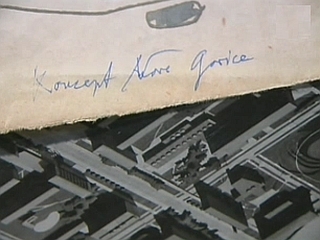
The Slovenian architect Joze Plečnik is widely praised for reshaping the appearance of Slovenia’s capital, but one of his students – a modernist named Edvard Ravnikar – left an enduring architectural legacy of his own in several towns across Slovenia.
Ravnikar was born in the Lower Carniolan town of Novo Mesto in 1907. His passion for architecture eventually led him to study the art in Ljubljana under the guidance of Plečnik, who was becoming widely acclaimed for his inventive reinterpretations of classical architectural elements. Ravnikar was determined to develop his own style, however, and he was increasingly drawn towards modernism. He went abroad and briefly studied under the auspices of the famed Le Corbusier just before World War II.
Plečnik was displeased with his Ravnikar’s independent-minded turn towards modernism and he eventually broke all ties with his former student, whom he had begun to see as a rival. But the old master’s reaction did not dissuade Ravnikar from pursuing his own architectural vision. He was inspired by modernism – particularly the Finnish school of architecture –, but was eager to incorporate influences from classical and folk architecture. The resulting style – with a strong element of brutalism in later years -- was recognizably his own, and was in many ways as inventive as Plečnik’s work.
In 1948, he received his first major commission: He designed the new Modern Gallery in Ljubljana after his sleek, modernist design won over the jury. Numerous other commissions followed.
One trademark of Ravnikar’s buildings was his playful use of unorthodox materials for his facades. In Ljubljana, he covered the offices of the newspaper Dnevnik in yellow plastic, and local wits soon named the building “The Canary.” In Kranj, meanwhile, he clad the Globus department store in rusty metal, much to the chagrin of architectural traditionalists.
Ravnikar’s work extended from architecture to urbanism. After World War II, the city of Gorizia was awarded to Italy, while much of its hinterland ended up in Yugoslavia. The Communist authorities decided to build a new town – Nova Gorica – and asked Ravnikar to come up with a master plan. The architect devised a thoroughly modern proposal with a grid system and plenty of greenery. Much to his disappointment, however, much of the plan ultimately remained unrealized.
Ravnikar’s most visible legacy, however, is the Republic Square in front of the Slovenian parliament and the two skyscrapers that tower above it, along with the nearby Maximarket department store. Together, these project help to define the very center of Slovenia’s capital. Nearby, he designed a residential complex known as Ferantov Vrt, and settled into one of the new apartments.
Ravnikar’s personal style also made him an admired teacher. Throughout his career, his work as a professor at the University of Ljubljana helped to promote his vision of a truly Slovenian style of modernism.
Ravnikar died in 1993. Although he never enjoyed the international fame accorded to Plečnik, he enjoys almost as great a stature in Slovenian architectural circles, and his best work is now valued almost as much as his onetime teacher’s timeless creations. Ravnikar’s legacy extends beyond his buildings, however; as a professor, he managed to pass on his knowledge and ideas to future generations of Slovenian architects – young people with strong artistic visions of their own.


































































